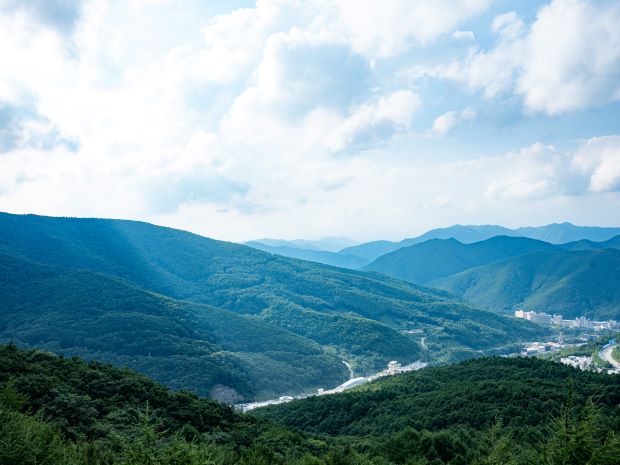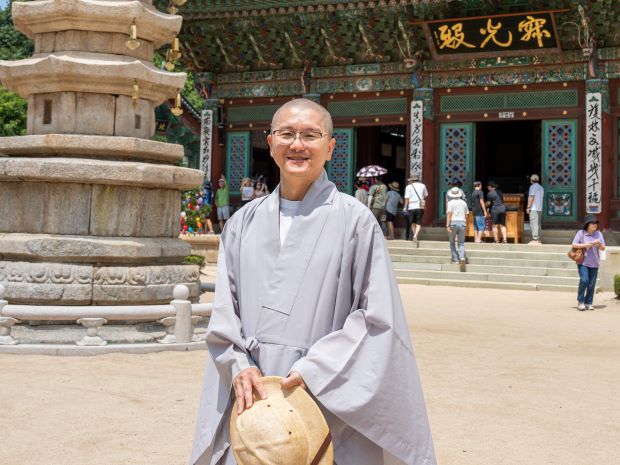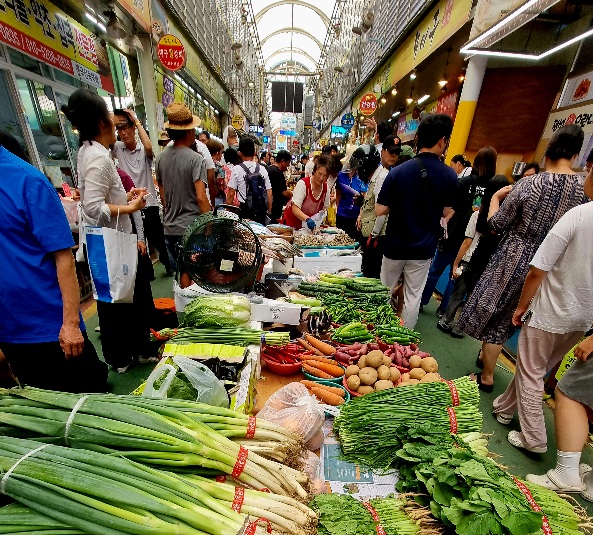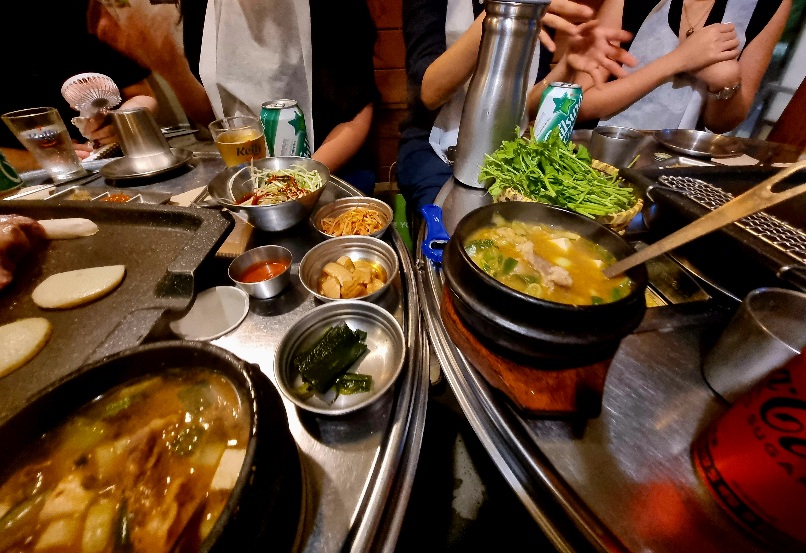- Daily & Weekly newsletters
- Buy & download The Bulletin
- Comment on our articles
Travel to South Korea for offbeat tourism, cutting-edge culture and culinary feasting
The streets of Seoul are buzzing – unsurprisingly for a city of over 9 million inhabitants – yet an air of tranquillity hovers over the constant flow of people. It’s the scorching summer, and as night falls and temperatures drop just a little, the lure of the outdoors is irresistible.
The lights of the city’s distinct neighbourhoods beckon with a mix of shopping, night markets and cafes and restaurants. Alongside the hi-tech glitter, there’s culture too: open-air public libraries with books and beanbags, and free entertainment in squares ranging from classical strains to synchronised beats.
But there is far more to the country than Seoul and the popular southern coastal city of Busan. With four distinct seasons, South Korea’s national parks, mountain ranges, temples and towns offer further insight into this fascinating nation.

Seoul highlights
Amid its modern architecture, Gyeongbokgung Palace is a haven celebrating Korean heritage. The majestic walled complex dating from the 14th century is filled with grand gates, ornate pavilions and a peaceful lake. It’s also home to the National Palace Museum and the National Folk Museum.
Although it suffered extensive damage during Japanese colonial rule and the Korean War, it has been undergoing reconstruction since the 1980s. Don’t miss the changing of the guard ceremony, while admiring people strolling around in traditional hanbok dress.
Towering skyscrapers surround a shining example of Seoul’s mission to regenerate its urban landscape. The Cheonggyecheon Stream (pictured, main image) is an incongruous babbling brook, 11km long, that wends through the city since its unearthing in the early 2000s. This oasis is lined with paths, bridges, trees and historic and artistic features; an inviting venue for couples, picnickers, buskers and anyone wanting to dip their feet in the cool water. When the sun sets and the buildings twinkle, Cheonggyecheon is at its most seductive.
The Myeongdong shopping district is awash with fashion labels and K-pop merch. It’s also home to beauty stores selling the skincare and cosmetics that are a magnet for shoppers all over Asia. Once you’ve stocked up on mask sheets at Olive Young or innisfree, peruse the night market for souvenirs and street food. Korean corn dogs, or K-dogs, are just one cult treat.

Hip Hongdae is ideal for shopping and youth culture. It’s another example of Seoul’s efforts to introduce a human element into the city while honouring its pre-colonial past. Red Road (pictured above) is a pedestrian-friendly cultural space, divided into zones for performances, that follows the track of a train line that once transported coal. Now the trail through shopping and green spaces is peppered with souvenirs of the city’s industrial past. Among the boutiques filled with adolescent apparel are vintage clothing stores with brand labels as well as quirky items.
Travelling around Korea
While it’s simple enough to master Seoul’s extensive public transport network and accommodation is easy to come by, some research is required before you explore other parts of the country. Bullet trains, car hire and joining a tour are the main options for moving around the provinces. While in the past, tourism infrastructure has been a little lacking, South Korea is now prioritising international visitors and promoting cultural attractions to encourage year-round travel.
High1 Resort - Gangwon State
Northeast of the capital is a mountainous region ideal for escaping the fierce summer heat. Surrounded by lush forests, snow-capped peaks and stunning waterfalls, High1 – also known as the “resort above the clouds” – takes advantage of its elevation to double as a ski resort. The complex has revitalised the region after the demise of coal mining in the area.

Its focus is on wellness, nature and sports, and as a public facility is aimed at all ages and budgets. The head of Tourism Contents Team, Kim Hye-jeong, outlines its programmes: “During the summer, we focus on water- and music-themed events, including DJ pool parties, music-infused flea markets and fireworks. In the autumn, we prepare wellness and busking performances, along with family hiking. For winter, we hold a traditional kimchi-making festival.”
Although less than 10% of visitors come from outside Korea, China and Japan, taekwondo, K-pop, K-dance and K-food are among the activities designed to entice international guests. The facility combines the convenience and comfort of an all-inclusive holiday with world-class facilities and even casinos, all in fantastic nature. Firework displays light up the green valleys at night, vying with the intense and colourful sunsets.
In the dense pine forests of Odaesan National Park is a Buddhist complex that welcomes visitors from all over the world, whatever their faith. Founded in 643, the temple was destroyed in the Korean War but has been carefully rebuilt to replicate its original features and grandeur, including an impressive central pagoda.

One of Buddhism’s holiest sites, its treasures include an original sarira, a skull fragment of Sakyamuni Buddha. It’s one reason the temple is regarded as a sacred space for healing, says Monk Woreom (pictured above), as he outlines the immersive Templestay programmes.
“Participants engage in two hours of devotional activities in the morning and afternoon, with a schedule that rotates every three months to balance rest and devotional activities,” he explains as he leads a meditative tea ceremony that requires everyone to be seated on the floor, cross-legged. The monk issues instructions for pouring and serving the tea according to mindfulness practices. An alternative one-month schedule is available “for those needing solitude”, which involves “personal cultivation” and assisting with chores around the temple.
Japanese and Chinese visitors once made up the majority of the temple’s international intake, but now Americans, Europeans and Africans are appreciating the experience in this secluded spot that is ideal for walkers as well as those seeking enlightenment.
Food, glorious food, but first some song!
Gangwon is home to Jeongseon, the hometown of traditional Arirang folksong. Helping to preserve and promote its cultural heritage, the Jeongseon Arirang Cultural Foundation is a charming centre where visitors can hear the music that originated with forestry workers in the 14th century.

The region’s woodland and coastline also harbour one of the country’s fine regional cuisines, with stalls at the local food market laden with produce. Among the specialities are meaty forest mushrooms – served with an olive oil sesame dip – grilled octopus and vegetable pancakes.
Renowned as one of the healthiest Asian cuisines, Korean food is best explored by tasting its traditional dishes. Centuries of hardship led to the population learning how to transform the most basic ingredients into nutritious and tasty morsels. Sweet, savoury and spicy flavours are layered via multiple side dishes – the focus is on fresh and seasonal – known as banchan. The most famous are the ubiquitous fermented cabbage kimchi and pepper paste gochujang. They usually accompany meat, fish or seafood, which can be roasted, fried or served in a broth.
Favourites include the fragrant, soothing and hearty chicken soup, samgyetang; the whole bird is stuffed with rice and submerged in a broth flavoured with garlic, jujube and ginseng for true Asian soul food. Bulgogi is thinly sliced marinated beef that translates as “fire meat”, served with rice and an assortment of sides. Tteokbokki consists of steamed and sliced rice cakes served with fish cakes enveloped in a tingling sweet and spicy chilli paste sauce. Discover the real KFC with a variety of crispy fried chicken dishes, often with a spicy kick, best washed down with beer.

Korean cuisine also draws on other Asian influences such as kimbap or gimbap, its own take on sushi, while steamed dumplings are succulent pockets of savoury fillings served with kimchi. For the ultimate sharing dish, Korean barbecue assembles favourite elements, with beef or pork cooked by diners and spicy cabbage thrown onto the hotplate with rice or noodles for a final flourish. It exemplifies how food in Korea is a communal experience reflecting the cultural value of coming together and enjoying both the company and the delicious dishes.
Photos: ©Sarah Crew; High1 Resort and Monk Woreom ©Lee Dong Wook (MCST)
Korea Unboxed: Taste, Glow, Explore is a new Brussels festival showcasing Korean tourism, beauty products and street food. 16-17 November 12.00 -21.00, Korean Cultural Center, Rue de la Régence 4 & Place de la Chapelle



















